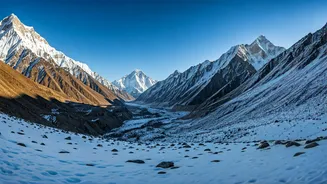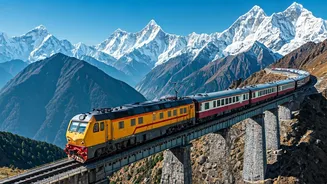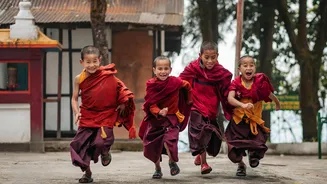A Journey Begins
The journey starts in a land that defies expectations: India's frozen valley. This isn't just a place of ice and snow; it's a living, breathing ecosystem
where people have carved out lives amidst the harshest conditions imaginable. The location, nestled in the mountains, presents a unique challenge, with freezing temperatures that plummet to an astonishing -25°C. This extreme cold defines the very nature of existence. The landscape itself is a testament to the power of nature, shaped by millennia of glacial activity, creating a surreal panorama of rugged beauty and icy desolation. It is an area defined by its remoteness and high altitude, making it a realm where survival itself is a daily achievement and the natural beauty is as challenging as it is captivating.
High Altitude Haven
The environment's altitude plays a crucial role in shaping life in the frozen valley. The higher you go, the thinner the air becomes, making breathing a significant adjustment. This thin air, coupled with the extreme cold, poses formidable health challenges for the inhabitants. Despite these hurdles, the people have demonstrated incredible resilience, developing unique adaptations to thrive in this demanding environment. The high altitude also influences the local ecosystem, affecting vegetation, and wildlife. The limited oxygen levels and intense solar radiation have created a specialized environment, and only the toughest species can survive in this high-altitude haven. This makes the area fascinating for anyone interested in biology, providing insights into the amazing adaptability of life.
Life in the Cold
Life in the frozen valley is a testament to human adaptability and resourcefulness. The communities have developed unique strategies to combat the cold and harsh conditions. They construct houses with thick walls for insulation and utilize traditional heating methods to maintain warmth during winter. Farming techniques have been adapted to the short growing season, with hardy crops like barley, buckwheat, and potatoes providing essential nourishment. Clothing is made from natural materials, such as yak wool, to provide effective protection against the bitter cold. These methods are passed down from generation to generation and have become a vital part of the cultural identity. The rhythm of daily life is intricately connected to the seasons and the availability of resources, demonstrating a remarkable harmony between humans and the environment.
The Road to Survival
The journey through the frozen valley highlights the incredible challenges faced by inhabitants daily. Extreme temperatures are not the only obstacles; challenges also stem from the remoteness of the region. Transportation and communication are often disrupted during winter, and accessing healthcare and essential supplies can be difficult. Despite these challenges, the residents have a deep understanding of their environment, and they leverage their local knowledge to survive. They develop a strong sense of community, helping each other during tough times. The survival of the people in the face of these obstacles demonstrates their resilience and strong spirit. It is an amazing example of humans' capacity to adapt and thrive in even the most extreme environments.
Natural Wonders Unveiled
This frozen valley is much more than a place of extreme cold; it's also home to some of the world's most spectacular natural wonders. The landscapes are shaped by glaciers, forming stunning valleys, towering mountains, and pristine lakes. The area is a haven for unique wildlife, including species adapted to the harsh conditions. The unique colors, created by the interplay of light and ice, make the landscapes magical. These natural wonders are not only beautiful but also fragile. Preserving these ecosystems is essential to safeguarding the extraordinary biodiversity and also for promoting sustainable tourism, which can generate income while protecting the environment. The natural wonders of the valley should be cherished and protected.
A Cultural Tapestry
Beyond its natural beauty, the frozen valley is defined by its rich culture and traditions. The people possess a strong sense of community and a unique way of life, shaped by the environment and their history. Their culture is often expressed through traditional arts, music, and dance, offering glimpses into their experiences, beliefs, and values. Local festivals and rituals are important events, providing opportunities for community gatherings and celebrating the heritage. The values of self-sufficiency, cooperation, and respect for nature are central to their way of life. Preserving these traditions is not only important for the community's identity but also for providing a glimpse into a unique way of life.











